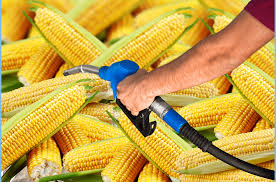Farmers shift to maize as biofuel push drives sales
By Zia Haq
A longstanding trend of farmers preferring cereal crops over scarce pulses and oilseeds has been bolstered by a craze for maize and its area shows a meteoric rise over the past few years.
Corn is a new favourite among growers due to its use in making ethanol for India’s high-priority biofuels programme. This summer, farmers have sown more maize than in any of the past five years.
The total area has jumped to 9.8 million hectares, which represents a 17% rise in the same period, latest official data showed. Output is also fast rising, growing by 11% in 2024-25 to nearly a quarter of a million tonnes.
Cultivators seem to be responding to measures to promote maize or corn as the next big commercial crop, after wheat and rice, to bolster its energy security through bumper harvests.
The country last month achieved the milestone of meeting its target of mixing 20% ethanol with petrol, early by four months, on the back of favourable policy steps to turn more of surplus rice as well as maize into the alcohol compound. Ethanol is also made from molasses, a by-product of sugar.
The biofuels programme has seen a huge success even though car-owners say blended gasoline tends to cut fuel economy. In 2021, Prime Minister Narendra Modi had advanced the target of blending petrol with 20% ethanol by five years to 2025, known as the E20 programme, to cut emissions and save up to $4 billion in oil imports annually.
The strategy has saved India nearly ₹1.40 lakh crore in crude import costs between 2014 and 2024, according to the data, helping cut 54.4 million tonnes of carbon dioxide emissions in the same period.
India aims to raise corn production by 10 million tonnes over the next five years as demand for ethanol production grows, besides higher demand from the poultry industry, which uses it as feed.
“The idea is that gradually, ethanol from sugarcane will plateau and grains such as maize will be used in its place,” a petroleum ministry official said, requesting anonymity.
Scientists at the Indian Institute of Maize Research are trying out new experiments to make high-yielding seeds under a federal programme to raise productivity by a wide margin, Hanuman Sahay Jat, the institute’s director, had told HT recently.
Oil marketing companies achieved the 20% goal in July, after having reached 19.92% in the previous month, with an output of 66 billion litres of ethanol during 2024-25, according to official data. Of this, 25.5 billion litres came from grains and the rest from sugarcane.
Farmers have always preferred cereals because of better price realisation for rice and winter-grown wheat, produced in surplus since they are purchased by the government at the minimum support price (MSP).
The base price for maize, slightly more than paddy, stands at ₹2,400 a quintal (100kg), an 83% increase over the price in 2013-14. MSP is a federally set floor price that offers at least 50% profit over cost.
“I switched to maize from soyabean last year, after I came to know about good profits from farmers in Uttar Pradesh,” said Virender Singh Tomar, a grower in Madhya Pradesh’s Neemuch.
Distilleries making ethanol have ramped up purchases after the government allowed an increase in the price of ethanol, one of the reasons why farmers are growing more. In January, the government hiked the ex-mill price of ethanol from ₹57.97 per litre, up from ₹56.58 per litre.
Backed by a plentiful monsoon, planting of cereals, especially rice and maize, has far outstripped that of pulses and oilseeds this year too.
This article has been republished from The Hindustan Times.

